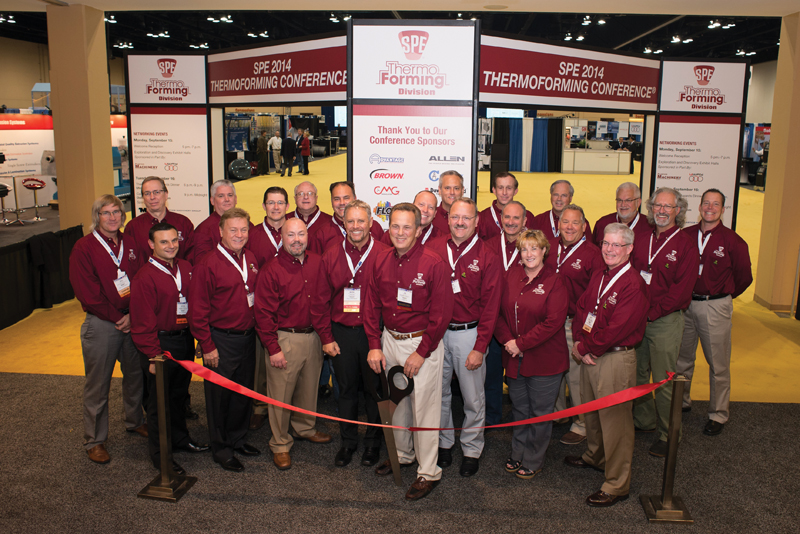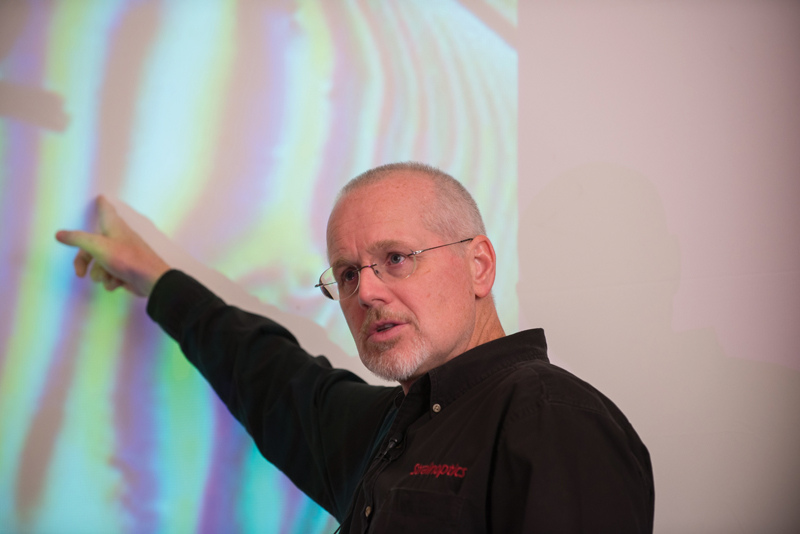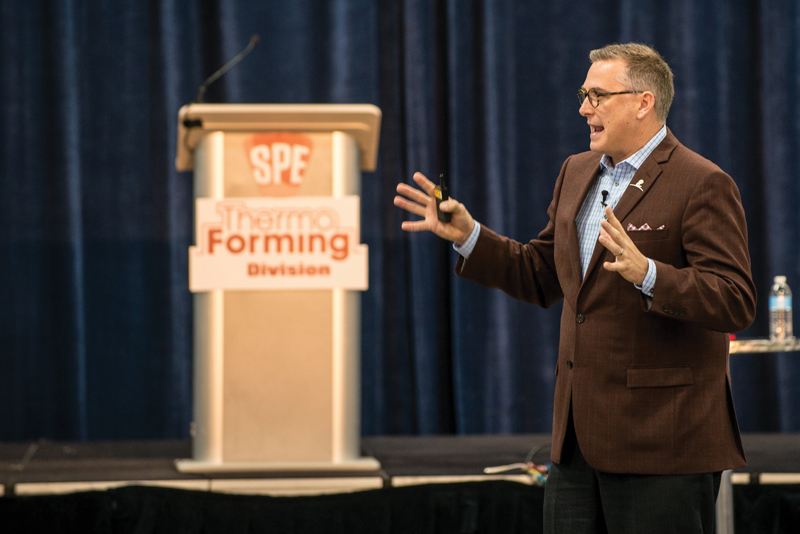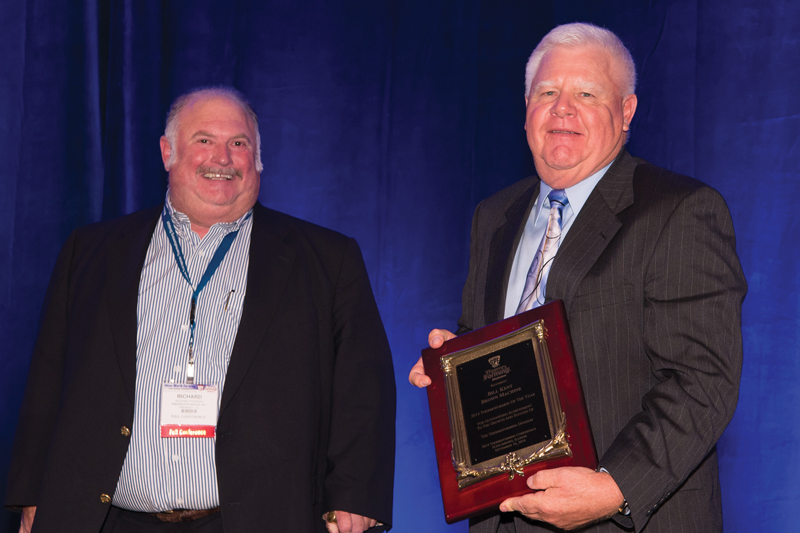Thermoformers Find “Ideas Worth Forming”
The 23rd Annual Thermoforming Conference advanced education and innovation
Previous Article Next Article
By Nancy D. Lamontagne
Thermoformers Find “Ideas Worth Forming”
The 23rd Annual Thermoforming Conference advanced education and innovation
Previous Article Next Article
By Nancy D. Lamontagne
Thermoformers Find “Ideas Worth Forming”
The 23rd Annual Thermoforming Conference advanced education and innovation
Previous Article Next Article
By Nancy D. Lamontagne

SPE Thermoforming Division’s board of directors opened the 23rd annual conference with a ribbon-cutting ceremony (photo courtesy of Dallager Photography).

SPE Thermoforming Division’s board of directors opened the 23rd annual conference with a ribbon-cutting ceremony (photo courtesy of Dallager Photography).

Tim Wilson from Strainoptics, Inc. overviewed how to diagnose stress-related problems using the ASTM D4093 method for “Photoelastic Measurements of Birefringence and Residual Strains in Transparent or Translucent Plastic Materials” (photo courtesy of Dallager Photography).

Tony Bridwell, chief people officer of Brinker International (the parent company of Chili’s and Maggiano’s Little Italy restaurants) presented a keynote address that emphasized the importance of employee accountability (photo courtesy of Dallager Photography).
Thermoformer of the Year
The SPE Thermoforming Awards Dinner recognized many leaders who’ve helped bring the industry to where it is today, and also looked to the future by awarding scholarships. The 2014 Thermoformer of the Year award went to Bill Kent, who has worked in thermoforming for more than 50 years.
Kent began as a technician with Brown Machine LLC in 1961, working for thermoforming pioneer Gaylord Brown. Kent was soon traveling the world as a sales engineer and was named Vice President of Advanced Technology in 1985. He remained in management at Brown Machine until retiring in 2012. Kent was a founding member of the SPE Thermoforming Division Board in the early 1980s and was re-elected to the Board of Directors in 1998, which he served on until 2011.
“I was very fortunate to work with one of the pioneers of our industry, and in my early years I also worked with many of the earlier recipients of this same award,” Kent said. “They were all very good mentors to me and taught me many things. They also all believed in and promoted the SPE and its efforts to promote education for those in our industry.”

Rich Freeman (left), last year’s SPE Thermoformer of the Year, presented Bill Kent with the 2014 SPE Thermoformer of the Year award (photo courtesy of Dallager Photography).
The theme “Ideas Worth Forming” was apparent throughout the SPE Thermoforming Division’s 23rd Annual Thermoforming Conference, held September 15-18, 2014, in Schaumburg, Illinois, USA. During the event, attendees from all over the world heard about new developments in thermoforming techniques, equipment, and materials, and also networked with colleagues.
Christian Majgaard gave an inspiring and informative keynote presentation “Pathways to Growth—Better Pick the Ones That Work!” Majgaard, a former top global manager with the toymaker Lego®, pointed out that many companies follow strategies that involve growth but haven’t asked themselves why they want to be larger. “My definition of business innovation is to increase the likelihood of doing well and reduce the risk of things going very bad,” he explained. Majgaard provided many useful examples from successful companies, including Lego.
A second keynote was presented by Tony Bridwell, chief people officer of Brinker International, the parent company of Chili’s and Maggiano’s Little Italy restaurants. His talk, “Culture is No Longer the Softer Side of Business,” emphasized the importance of accountability. “Accountability begins with clearly defining the results—that is the key,” said Bridwell. He emphasized ways to develop accountability within a company, such as making sure that results are memorable, measurable, and meaningful.
The conference also included full-day practical workshops on cut sheet thermoforming, roll fed thermoforming, and extrusion—as well as plant tours to Thermoform Engineered Quality in Huntley, Illinois, and Processing Technologies International, LLC in Aurora, Illinois. In the exhibit hall, attendees spoke with vendors that provide equipment, materials, tooling, and services; the companies meanwhile presented “Innovation Briefs” on new products and services.
New Ideas for Thermoforming
This year’s technical sessions covered new technology as well as practical guidelines for improving processes.
During the roll fed technical presentations, Tim Wilson from Strainoptics, Inc. overviewed how to diagnose stress-related problems in thermoforming. He pointed out how important measuring stress is for optimizing processes, improving product quality, and preventing failures, and he outlined how to analyze stress using ASTM D4093 standard test methods.
Dino Caparco of Yushin America, Inc. presented the advantages of using robotic stacking for thermoformed parts. He detailed the tracking automation method, which is typically used when parts remain in the web intact and are freed as the material passes over the roller. He also explained that non-tracking automation is used when parts are extracted from the up-stacker. Whether a tracking or non-tracking robotic system is installed, operator training is key, as is picking the right robotic stacking tooling, he added.
During the joint technical sessions, Dave Morgese from The FoxMor Group, Inc. and Bill Gerlach from Brabazon Pump, Compressor & Vacuum teamed up for a creative presentation that compared using individual vacuum pumps with using a central vacuum system for thermoforming. They aimed to overcome fear of the unknown, which they cited as one of the main factors preventing companies from converting to a central vacuum pump system.
Jonathan Kirschner and Rachel Benyola of AIIR Consulting, LLC also led an interactive workshop on succession planning. They introduced the topic by explaining the importance of succession planning in making transitions in leadership smooth and keeping a company profitable even with changes in leadership. They emphasized the importance of having a pipeline of future leaders and got everyone thinking about leadership qualities through an interactive activity.
Ryan Hunt of Algix, LLC presented a cut sheet presentation on life-cycle assessments, which quantify and interpret the flows to and from the environment for a product. Hunt walked through the steps required for a life-cycle assessment and showed that a masterbatch of half polystyrene and half algae dramatically reduced most environmental impacts—and that combining algae with PLA bioresin can make PLA even more environmentally friendly and thus even more competitive.
John Davidson of Distortion Arts, LLC presented on the exciting opportunities and advancements in distortion forming. Distortion Arts uses a computerized approach to gather the data necessary for repeatable distortion forming, which is faster and cheaper than using trial and error, common in the past. He talked about state-of-the-art technology that allows high-resolution digital printing to be combined with very complex geometries, and showed several examples of impressive distortion-formed products.
Blake Johnson from Lanier Color Co. gave practical advice regarding accurate color matching. He provided a useful list of what a color house needs to make the best possible match and a quality part, such as a firm, agreed-upon color target, the final application for the product, the light source where it will be reviewed (ideally the same as where the customer will view the part), and the exact grade of base resin. Other key information includes the processing parameters, the color tolerances for the part, how the color will be evaluated (visual or spectrophotometer), the expected life span of the part, any need for functional additives, the part thickness, and any known regulatory requirements.
Overall, 2014’s Annual Thermoforming Conference was a success. Attendees gained many new ideas and perspectives on thermoforming and growing their companies and also connected with others in the industry.